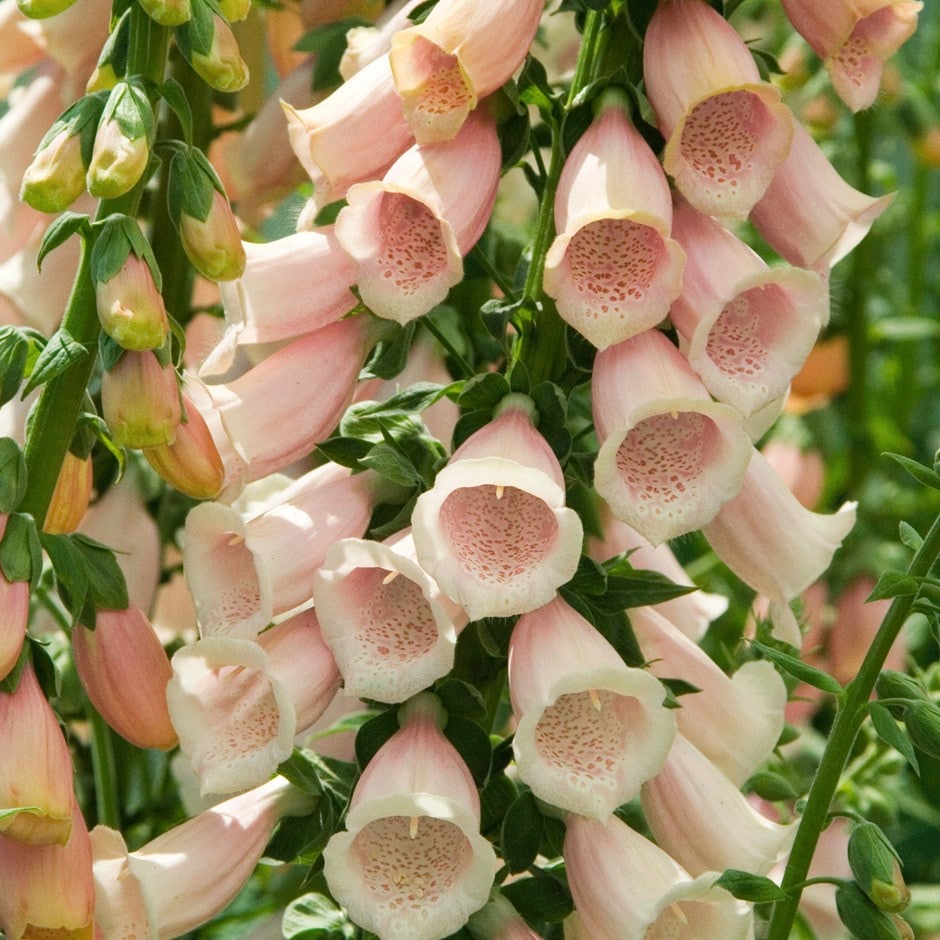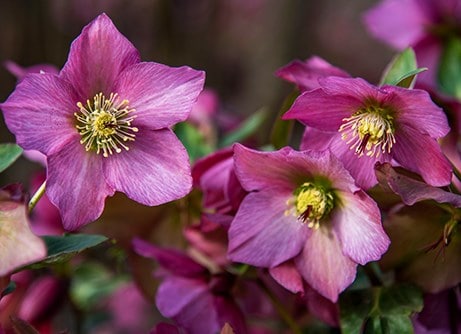
Digitalis purpurea 'Sutton's Apricot' produces tall, elegant flower spikes adorned with soft apricot-pink tubular blooms, each marked with maroon spotting inside the throat. These flowers open gradually from the base upwards, providing a long-lasting display from early summer.
This semi-evergreen biennial, occasionally perennial, reaches up to 1.5m (5ft) in height and features lance-shaped, slightly hairy green leaves. Its unique warm apricot tones and refined flower form make it a popular choice for cottage gardens, woodland edges, and wildlife-friendly spaces, where it attracts bees and other pollinators.
This semi-evergreen biennial, occasionally perennial, reaches up to 1.5m (5ft) in height and features lance-shaped, slightly hairy green leaves. Its unique warm apricot tones and refined flower form make it a popular choice for cottage gardens, woodland edges, and wildlife-friendly spaces, where it attracts bees and other pollinators.
How to care for Digitalis purpurea Sutton's Apricot:
Plant into a lightly shaded, well-prepared border or woodland margin with plenty of organic matter (well-rotted compost).
Ensure that the soil is kept moist in summer. After the first flowerspikes have finished flowering, cut them back to encourage sideshoots to develop, which can go on to provide a second flush of flower. Then, when the last of these have died off, cut them all down to the ground.
Apply a generous 5-7cm (2-3in) mulch of well-rotted organic matter around the plant in early spring.
These plants are mainly biennial, although they will often self-seed freely.
Ensure that the soil is kept moist in summer. After the first flowerspikes have finished flowering, cut them back to encourage sideshoots to develop, which can go on to provide a second flush of flower. Then, when the last of these have died off, cut them all down to the ground.
Apply a generous 5-7cm (2-3in) mulch of well-rotted organic matter around the plant in early spring.
These plants are mainly biennial, although they will often self-seed freely.
Sowing instructions:
Lightly press the seed onto the surface of a well-watered seed compost in mid to late spring and keep in a cold frame. When large enough to handle, pot on into individual cells and once they have developed a decent basal rosette of foliage they can be hardened off before planting out. They will usually start to flower in their second year.
Flowering period:
- Jan
- Feb
- Mar
- Apr
- May
- Jun
- Jul
- Aug
- Sep
- Oct
- Nov
- Dec
Eventual height:
1.5m
Eventual spread:
0.5m
Position:
Light shade
Rate of growth:
Average
Soil:
Moderately fertile, moist, well-drained soil
Hardiness:
Fully hardy
-
This perennial dies back to below ground level each year in autumn, then fresh new growth appears again in spring.
-
Humans/Pets: TOXIC if eaten
Product options

9cm pot
£8.99
In stock
(shipped within 2-3 working days)
(shipped within 2-3 working days)

3 × 9cm pots
£19.99
£6.66 each
In stock
(shipped within 2-3 working days)
(shipped within 2-3 working days)

6 × 9cm pots
£36.99
£6.17 each
In stock
(shipped within 2-3 working days)
(shipped within 2-3 working days)

approx 150 seeds
£2.25
In stock
(shipped within 2-3 working days)
(shipped within 2-3 working days)
1
Delivery options (pick your preferred option at checkout)
Standard Delivery£5.99
Named Day Delivery£10.99
Goes well with
Polystichum setiferum Plumosomultilobum Group
soft shield fern ( syn. Plumosum Densum )
From £9.99
View options
| 2 litre pot | £18.99 |
|
| 9cm pot | £9.99 |
|
| 3 × 9cm pots | £24.79 |
|
| 3 × 2 litre pots | £44.99 |
|
View details
Aster × frikartii 'Mönch'
michaelmas daisy ( syn. Aster Monch )
From £8.99
View options
| 2 litre pot | £17.99 |
|
| 9cm pot | £8.99 |
|
| 3 × 9cm pots | £19.99 |
|
| 6 × 9cm pots | £34.99 |
|
| 3 × 2 litre pots | £44.99 |
|
View details
Campanula glomerata 'Superba'
clustered bellflower
From £8.99
View options
| 2 litre pot | £18.99 |
|
| 9cm pot | £8.99 |
|
| 3 × 9cm pots | £19.99 |
|
| 6 × 9cm pots | £37.99 |
|
| 3 × 2 litre pots | £49.99 |
|
View details










